Qualcomm Snapdragon 805 Performance Preview
by Anand Lal Shimpi on May 21, 2014 8:00 PM EST- Posted in
- Tablets
- Snapdragon
- Qualcomm
- Mobile
- SoCs
- Snapdragon 805
CPU Performance
As always we'll start out our performance investigation with a handful of CPU bound web browser based tests. In all cases we used Chrome on the MDP/T. Remember there's only an 8% increase in peak CPU frequency here, so I wouldn't expect a huge difference vs. Snapdragon 801.

Here the MDP/T scales pretty well, showing a 6% improvement in performance over the Snapdragon 801 based Galaxy S 5. In the case of the GS5 we are looking at a 2.5GHz Snapdragon 801 implementation, so the improvement makes sense. Both the Cortex A15 (TF701T/Shield) and Apple's Cyclone (in the iPad Air) are higher performing designs here. Since there's no fundamental change to Krait's IPC, the only gains we see here are from the higher clock speed.
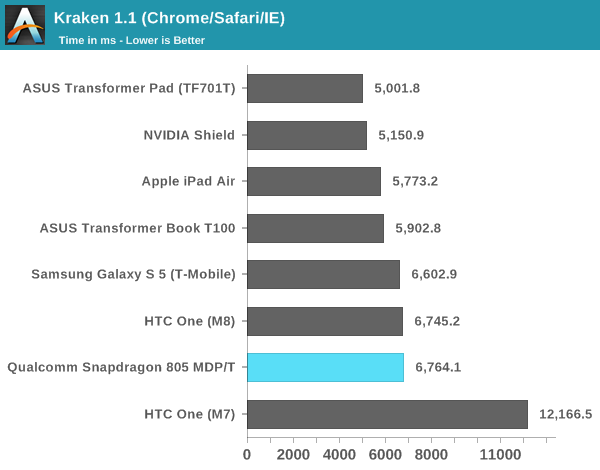
Kraken appears to be at its limit when it comes to Krait 400/450, there's effectively no additional frequency scaling beyond 2.3GHz. We're either running into an architectural limitation or limits of the software/browser combination itself.
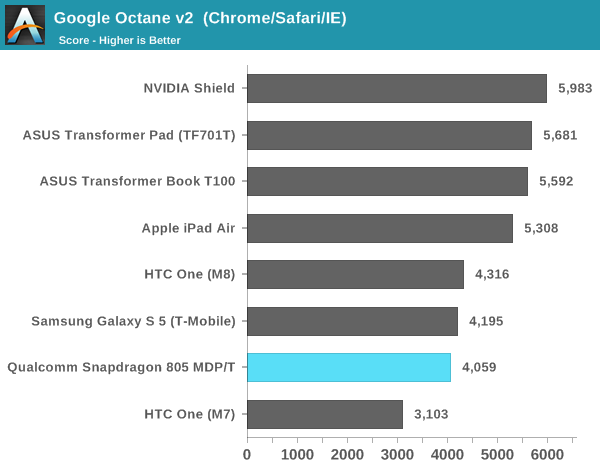
Similarly we don't see any real progress in the Google Octane test either. Snapdragon 805's CPU cores may run at a higher peak frequency but that's definitely not the story here.
Basemark OS II
Basemark OS II gives us a look at native application performance across a variety of metrics. There are tests that hit the CPU, GPU as well as storage subsystems here. The gains here are exclusively on the graphics side, which makes sense given what we've just seen. Snapdragon 805's biggest gains will be GPU facing.
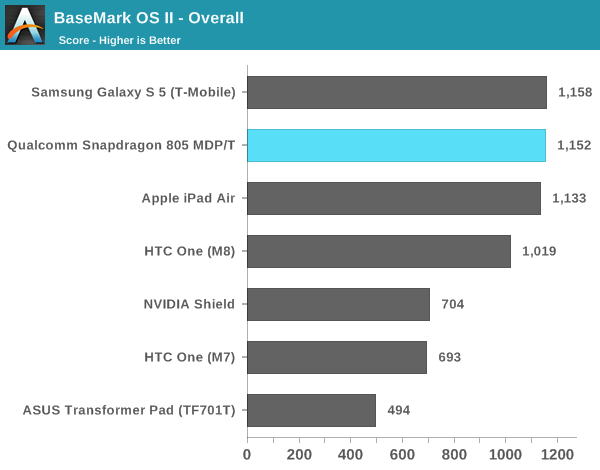
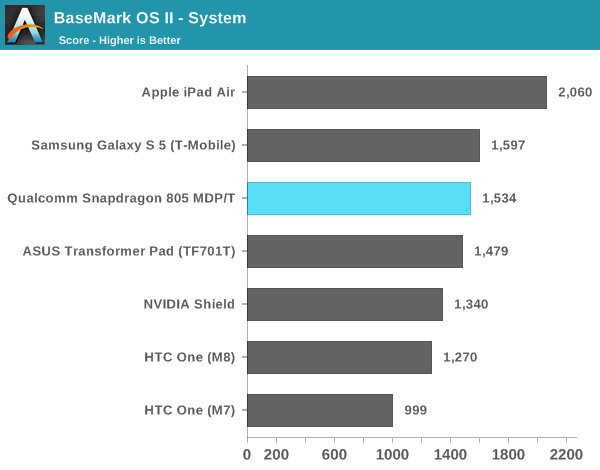

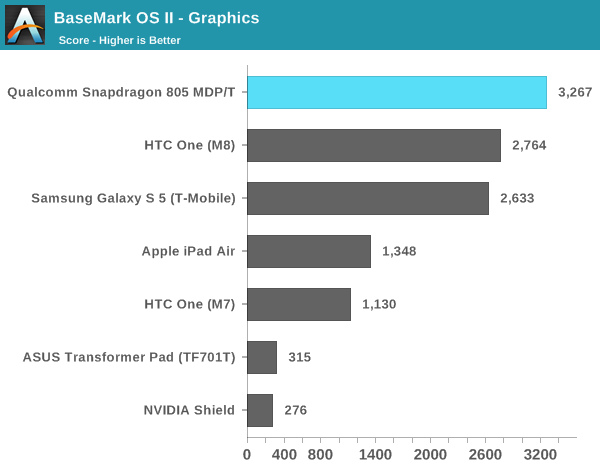
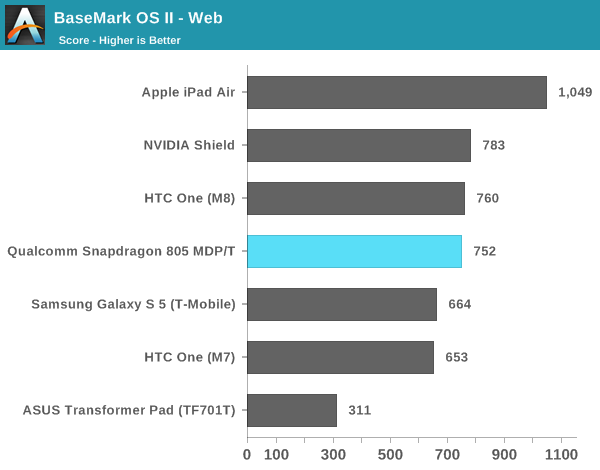
Geekbench 3.0
Although I don't typically use Geekbench, I wanted to include some numbers here to highlight that the increase in memory bandwidth for S805 over S801 doesn't really benefit the CPU cores:
| Geekbench 3.0 | |||||
| Snapdragon 801 2.3GHz (HTC M8) | Snapdragon 805 2.7GHz (MDP/T) | % Increase for S805 | |||
| Overall (Single thread) | 1001 | 1049 | 4.8% | ||
| Overall (Multi-threaded) | 2622 | 2878 | 9.7% | ||
| Integer (Single thread) | 956 | 996 | 4.2% | ||
| Integer (Multi-threaded) | 2999 | 3037 | 1.3% | ||
| FP (Single thread) | 843 | 925 | 9.7% | ||
| FP (Multi-threaded) | 2636 | 3155 | 19.7% | ||
| Memory (Single thread) | 1411 | 1406 | 0% | ||
| Memory (Multi-threaded) | 1841 | 1949 | 6% | ||
I wouldn't read too much into the multithreaded FP results, I suspect we're mostly seeing differences in thermal dissipation of the two test units. A closer look at the memory bandwidth numbers confirms that while the 805 has more memory bandwidth, most of it is reserved for GPU use:
| Geekbench 3.0 - Memory Bandwidth | |||||
| Snapdragon 801 2.3GHz (HTC M8) | Snapdragon 805 2.7GHz (MDP/T) | % Increase for S805 | |||
| Stream Copy (Single thread) | 7.89 GB/s | 8.04 GB/s | 1.9% | ||
| Stream Copy (Multi-threaded) | 9.53 GB/s | 10.1 GB/s | 5.9% | ||
| Stream Scale (Single thread) | 5.36 GB/s | 5.06 GB/s | - | ||
| Stream Scale (Multi-threaded) | 7.31 GB/s | 7.63 GB/s | 4.3% | ||
| Stream Add (Single thread) | 5.27 GB/s | 5.2 GB/s | - | ||
| Stream Add (Multi-threaded) | 6.84 GB/s | 7.51 GB/s | 9.8% | ||
| Stream Triad (Single thread) | 5.64 GB/s | 5.85 GB/s | 3.7% | ||
| Stream Triad (Multi-threaded) | 7.65 GB/s | 7.89 GB/s | 3.1% | ||










149 Comments
View All Comments
B.Jay - Wednesday, May 21, 2014 - link
Too bad it seems like the LG G3 might not have this beast... So close LG, so close!erikiksaz - Wednesday, May 21, 2014 - link
I wonder what the scrolling performance will be like on the G3 given its resolution and "just" having an 801 chip. I feel like scrolling performance is finally good with the 1080p and the latest generation of processors, but are we going backwards in performance with the leap to 4k?Impulses - Thursday, May 22, 2014 - link
Still dunno why they're pushing for even higher DPI on phones, seems almost absurd at this point.piroroadkill - Thursday, May 22, 2014 - link
Because people are very, very simple in the head and think bigger numbers are better.Frenetic Pony - Thursday, May 22, 2014 - link
"Now assembled by 100% more unpaid Chinese interns!"Vayra - Monday, June 2, 2014 - link
High DPI phones will hopefully die a silent and quick death. Even 1080p is overkill for me on any screen smaller than 5 inch, and staying at 720p at that size is great for battery life...Teo222 - Thursday, June 5, 2014 - link
I don't know man. The difference in pushing and power consumption and price between 720p and 1080p is not that much to deter from the noticeably better quality.Say what you will but I (with my less than perfect vision) can still see pixelation at battery indicators or other small elements. Not to mention native full HD content should you wish it. and obviously SOCs today able to cope with 1080p.
Sabresiberian - Thursday, May 22, 2014 - link
I'm not sure why some people spend as much effort deriding the push for higher pixel densities as they do. Most of it sounds more like sneering for the sake of sneering than having an actual point to make, to me (I'm not saying I know that to be the case here). One should at least make the effort to differentiate himself from the person telling us we should not try to improve the quality of what we see by reaching for more than 60 DPI not all that long ago, because that was "good enough".Human vision isn't the simple mechanism some people think it is. Research has shown a density of over 600 DPI can be useful. I tend to agree that there are other ways to make smart phones better at this point, and it's hard for me to imagine that I would be able to see any benefit beyond 300 DPI personally, but I'm not against increasing the ability of our technology to do more than we can use. Perhaps the technology will lead to improvements in other areas, like responsiveness, or fluidity. Seems to me that giving designing engineers all the power they could possibly use can't be a bad thing. :)
Egg - Friday, May 23, 2014 - link
Increased power draw, cost, performance issues.Frenetic Pony - Saturday, May 24, 2014 - link
Hey looks reasons!